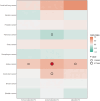Pan-cancer analysis of the impact of fatty acids: a two-sample and multivariable Mendelian randomization study
- PMID: 40591044
- PMCID: PMC12214094
- DOI: 10.1007/s12672-025-03010-3
Pan-cancer analysis of the impact of fatty acids: a two-sample and multivariable Mendelian randomization study
Abstract
Background: This study used Mendelian randomization (MR) to investigate the causal association between circulating fatty acids (FAs) and the incidence of 10 human cancer types.
Methods: Single nucleotide polymorphisms (SNPs) significantly associated with circulating FAs were selected from 500,000 UK Biobank blood samples and 114,999 plasma samples from a large GWAS. Summary-level data on 174,006 cancer patients were obtained from the FinnGen biobank. The inverse variance weighted method was used for causal estimation, with additional analyses including MR-Egger regression, weighted median, weighted mode, Cochrane Q test, MR-PRESSO global test, and leave-one-out analyses. Multivariable Mendelian randomization (MVMR) was applied to adjust for potential confounders.
Result: This study found a genetically causal effect of polyunsaturated FAs on kidney cancer incidence (OR: 1.528; 95% CI 1.164-2.266; P = 0.001), which remained significant after Bonferroni adjustment. The causal impact of omega-6, omega-3, and linoleic acid on kidney cancer risk was also observed (omega-6: OR = 1.586, P = 0.002; omega-3: OR = 1.311, P = 0.014; linoleic acid: OR = 1.527, P = 0.007). MVMR confirmed the consistent causal relationship (OR = 1.553, P = 0.0047) after adjusting for multiple variables. Results were validated in a larger cohort.
Conclusions: Higher circulating polyunsaturated FAs, especially omega-6, were associated with an increased risk of kidney cancer. Suggestive associations were found in small cell lung, rectal, bladder, pancreatic, and esophageal cancer.
Keywords: Kidney cancer; Mendelian randomization; Pan cancer analysis; Saturated fatty acid; Unsaturated fatty acid.
© 2025. The Author(s).
Conflict of interest statement
Declarations. Ethics approval and consent to participate: This study only used publicly available data. No original data were collected. Ethical approval for each of the studies included in the investigation can be found in the original publications. Consent for publication: Not applicable. Competing interests: The authors declare that they have no competing interests.
Figures





Similar articles
-
Genetically predicted the causal association between serum mineral elements with immune thrombocytopenia and Henoch-Schonlein purpura: a bidirectional two-sample Mendelian randomization analysis.Thromb J. 2025 Jun 16;23(1):65. doi: 10.1186/s12959-025-00756-2. Thromb J. 2025. PMID: 40524203 Free PMC article.
-
The relationship between polyunsaturated fatty acids and inflammation: evidence from cohort and Mendelian randomization analyses.Int J Epidemiol. 2025 Jun 11;54(4):dyaf065. doi: 10.1093/ije/dyaf065. Int J Epidemiol. 2025. PMID: 40550517 Free PMC article.
-
Bidirectional Causal Relationship Between Myopia and Neurodegenerative Diseases: Two-Sample Mendelian Randomization Analyses.Br J Hosp Med (Lond). 2025 Jun 25;86(6):1-19. doi: 10.12968/hmed.2025.0183. Epub 2025 Jun 18. Br J Hosp Med (Lond). 2025. PMID: 40554439
-
Omega-3 fatty acids for depression in adults.Cochrane Database Syst Rev. 2021 Nov 24;11(11):CD004692. doi: 10.1002/14651858.CD004692.pub5. Cochrane Database Syst Rev. 2021. PMID: 34817851 Free PMC article.
-
The association between human papillomavirus and bladder cancer: Evidence from meta-analysis and two-sample mendelian randomization.J Med Virol. 2023 Jan;95(1):e28208. doi: 10.1002/jmv.28208. Epub 2022 Oct 25. J Med Virol. 2023. PMID: 36226344 Free PMC article.
References
-
- Sung H, Ferlay J, Siegel RL, Laversanne M, Soerjomataram I, Jemal A, et al. Global cancer statistics 2020: GLOBOCAN estimates of incidence and mortality worldwide for 36 cancers in 185 countries. CA Cancer J Clin. 2021;71(3):209–49. - PubMed
-
- Mantovani A. Cancer: inflammation by remote control. Nature. 2005;435(7043):752–3. - PubMed
Grants and funding
LinkOut - more resources
Full Text Sources
Research Materials
Miscellaneous
